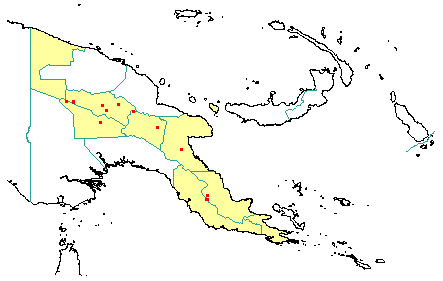
in PNGplants database
PNGTreesKey – Paraserianthes falcataria subsp. fulva (Lane-Poole) I.C.Nielsen |
Barry Conn (NSW) & Kipiro Damas (LAE).
Guide to trees of Papua New Guinea
Copyright held by the authors, National Herbarium of New South Wales, and Papua New Guinea National Herbarium
Report Forest Research of Papua New Guinea 91 (1925)
Other Literature: B. Verdcourt, A Manual of New Guinea Legumes 184 (1979)
Family: Fabaceae
Dicotyledon
Timber Group: Occasional timber species
Field Characters: Emergent tree (up to 52 m high), Large canopy tree, or Small sub-canopy tree; Bole cylindrical (25-100 cm diam.); straight (bole up to 22 m long); buttresses buttresses absent; spines spines absent; aerial roots aerial roots absent; stilt roots stilt roots absent; Bark green or grey, slightly rough or smooth, slightly pustular, lenticels rounded/swelling; less than 25 mm thick; bark blaze consisting of one layer; faintly to non-aromatic; outer blaze white (cream-coloured), orange, or red, with stripes (reddish); inner blaze white (cream-coloured), orange, or red, with stripes (reddish); bark exudate (sap) present, colourless, not readily flowing (spotty), colour not changing on exposure to air, not sticky; terminal buds not enclosed by leaves.
Indumentum: Complex hairs absent; stinging hairs absent; mature twig indumentum (hairs) present, hairs dense.
Leaves: Leaves spaced along branches, spiral (leaves occurring singly at a node and arranged spirally up the branchlet), compound (a leaf made up from two or more leaflets); petiole present, not winged, attached to base of leaf blade, not swollen; leaves bipinnate (with the rachis branched once); petiolule not swollen; rachis present, absent, absent; leaves without a terminal leaflet (the number of leaflets even - paripinnate), broadest at or near middle or broadest below middle, 1.2 cm, 0.4 cm, leaflets opposite, symmetric; venation pinnate, secondary veins open, prominent, intramarginal veins absent; leaves lower surface pale green, upper surface green, indumentum (hairs) present, indumentum (hairs) dense (rusty red-coloured hairs); absent; domatia absent; stipules absent.
Flowers: Inflorescence axillary, flowers on an unbranched axis, cones absent; flowers bisexual, stalked, flowers with many planes of symmetry, 6.0-8.0 mm long, diameter small (up to10 mm diam.); perianth present, with distinct sepals and petals whorls, inner perianth white, yellow (creamy), or brownish green; (4-) 5 (-6), some or partly joined; stamens 19-50, present, joined, free of the perianth; ovary superior, carpels joined (when more than one), locules 1; styles solitary, 1.
Fruits: Infrutescence arranged on unbranched axis, fruit 95.0-160.0 mm long, brown, not spiny, non-fleshy, simple, dehiscent, legume; seeds 14 (c.), to about 5 mm long (c. 6 mm long), not winged, narrow (longer than wide), seed 1-10 mm diam. (3-4 mm wide).
Distribution: West Sepik, Morobe, Western Highlands, Eastern Highlands, Southern Highlands, Central, Northern & Milne Bay.
 | Botanical records in PNGplants database |
Notes: Notes This subspecies is morphologically very similar to Paraserianthes falcataria subsp. falcataria. It differs from the latter subspecies by having rusty red-coloured hairs on the branchlets and leaves, whereas the latter has similar hairs on the branchlets but the leaves are covered with very fine short hairs; fruits (9.5-16 cm long) which tend to be larger than those of subsp. falcataria which are 9-12 cm long.
This subspecies was previously known as Albizia fulva C.T.White & Francis ex Lane-Poole. It is classified in Fabaceae subfamily Mimosoideae or in the separate family Mimosaceae.